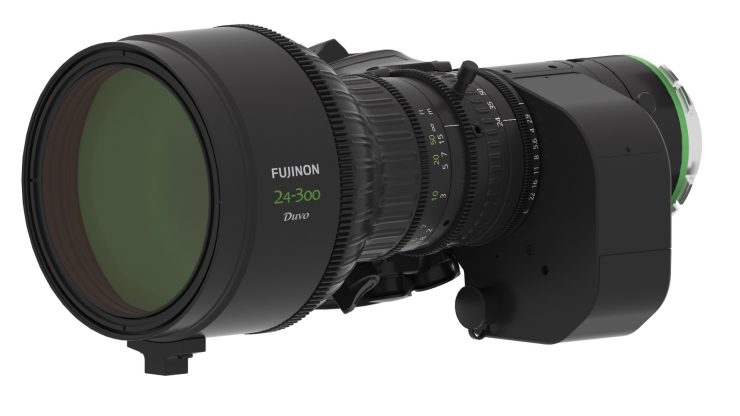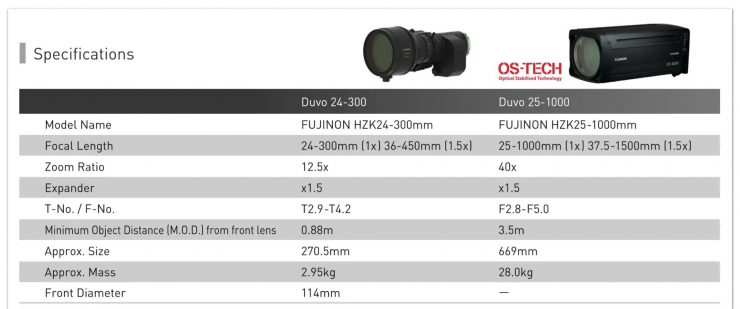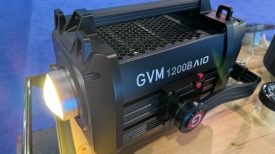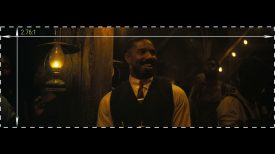
Fujifilm has announced that its FUJINON Duvo HZK24-300mm dual format zoom lens that supports Super 35mm and full-frame sensors (with the 1.5x expander engaged) will start shipping at the end of this month.
The lens was designed to be used with S35 digital cinema cameras that have a PL mount in ENG-type environments for sports, live events, documentaries, etc.
We first saw the FUJINON Duvo HZK24-300mm at NAB 2023.

Most cinema lenses have a much smaller zoom magnification ratio than that of broadcast lenses and they weigh a lot more. They also often require a focus puller, which is uncommon in the broadcast industry. Fujifilm set out to change this by creating a compact, lightweight, portable lens that they could add to the Duvo Series lens lineup for coverage of live sporting events, music concerts, documentaries, and wildlife cinematography.

Key features
- The 31.5mm diameter image circle covers up to Super35 sensors.
- ENG-style, digital drive unit with zoom rocker switch.
- Industry-standard 0.8 MOD film pitch gears for focus, zoom, and iris control.
- Power and data/control connections to the camera via the rear PL mount “hot shoe.”
- The 16-bit encoding supports sharing LDS and /i Technology lens data with the camera.
- The barrel markings in metric or imperial measurements are switchable in the field.
- Glow-in-the-dark barrel markings make it easier to read measurements.
- A 280° focus barrel rotation for more precise focus adjustments.
- The 120° zoom rotation
- No shims are required to adjust the flange focal distance.
- Macro focus function available.

The Duvo 24-300mm delivers a 12.5x zoom, covering the frequently used 24-300mm focal range. By using the built-in 1.5x extender, you can turn the lens into a 36-450mm with the caveat of loosing about 1.5 stops of light. The expander need to be engaged if you want it to cover full-frame camera sensors.
The lens has a maximum aperture of T2.9, but it does ramp up to T4.2 once you get over around 200mm.
At 24mm, the lens can focus at a distance of just 10.65″ / 27.05cm. It also features a built in macro adjustment like you find on a lot of ENG 2/3″ lenses.
Size & Weight

The FUJINON Duvo HZK24-300mm looks to be a very versatile portable lens that can be used with a tripod, shoulder-mounted with a Steadicam, or used with a crane. It is 27cm / 10.65″ in length and it weighs just 2.95 kg / 6.5 lb.

So how does that size and weight compare to the closest competition? Well, let’s find out.
| WEIGHT | LENGTH | |
| FUJINON Duvo HZK24-300mm | 2.95 kg / 6.5 lb | 27cm / 10.65″ |
| FUJINON ZK25-300mm T3.5 to T3.85 Cabrio | 8.9 kg / 19.6 lb | 40.1 cm / 15.8″ |
| Canon CINE-SERVO 25-250mm T2.95 | 3.04 kg / 6.7 lb | 27.43cm / 10.8″ |
This isn’t their first rodeo

This isn’t the first time FUJINON has made a cine servo zoom with this type of focal range. The ZK25-300mm T3.5 to T3.85 Cabrio Lens (PL Mount) has been around for many years, however, that lens is around 3x heavier and about 50% longer in length.
Duvo Series
In March last year, Fujifilm announced the FUJINON HZK25-1000mm F2.8-F5.0 PL Mount (Duvo 25-1000) box-type broadcast zoom lens, also known as “Duvo Box”. The Duvo 25-1000, is also a Super 35 lens.

Price
The FUJINON Duvo HZK 24-300mm retails for $31,999 USD which makes it very good value for money given its focal range, size, and weight.
Competition

Direct competition for the FUJINON Duvo HZK 24-300mm comes in the form of FUJINON’s own ZK25-300mm T3.5 to T3.85 Cabrio Lens (PL Mount) which retails for $44,000 USD and the Canon CINE-SERVO 25-250mm T2.95 Cinema Zoom Lens (PL Mount) which retails for $29,999 USD.
Thoughts

The FUJINON Duvo HZK 24-300mm is probably going to be a very popular lens, especially for sports coverage. I can see NFL films and the NBA buying quite a few of these. A lens with this zoom range that is under 3kg is an impressive feat of engineering.
They would also be good choices for documentary coverage and when shooting certain types of wildlife.

One of the caveats with these type of cine zooms when shoulder mounting them is that most of the weight is located at the front of the lens and this can put a lot of pressure on your wrist and forearm. You can also have issues with balancing your rig as you need to push it a long way back on your shoulder which can make it difficult to access camera controls. It also means that they are more suitable to use with mid to large sized digital cinema cameras.
The other caveat is that 24mm is not overly wide on a S35 sensor and arguably some users would prefer to have a wider lens at the expense of having the extra length. The problem is, its a lot easier to make a zoom that starts at 24mm than one that starts at 18mm if you need to have a large focal range and keep the weight to a minimum.





